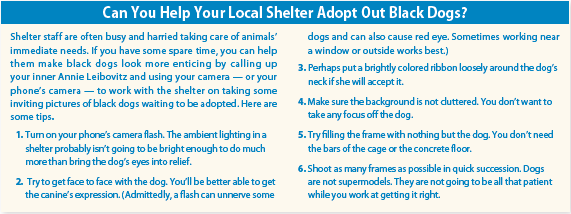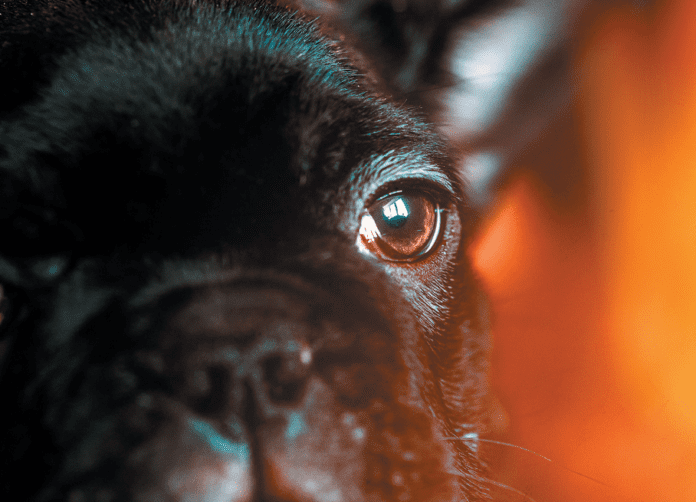At least as far back as the 1700s, black dogs have been getting a bad rap. The writer Samuel Johnson used the phrase “The Black Dog” to describe melancholy and depression, as did Winston Churchill in the twentieth century. In Arthur Conan Doyle’s The Hound of the Baskervilles, black is the color of the demonic canine. And The Grim, a menacing black dog in Harry Potter and the Prisoner of Azkaban, portends death for anyone who comes across him.
What goes for books also goes for movies. Veterinarian and Tufts professor emeritus Nicholas Dodman has said that “black is Hollywood code for sinister, while white stands for good, pure. So a horrific dog on the screen is never going to be a harlequin Great Dane or a white dog.” Even the dog on “Beware of Dog” signs tends to be black.
Is it any wonder, then, that black dogs are often perceived as less adoptable and more likely to be euthanized? The question is, is it true? Are black dogs particularly apt to end up homeless — and then be put down when they go unadopted because shelters need to make room for more incoming dogs?
The true plight of black dogs
Whether black dogs are more likely to be passed over in favor of dogs of other colors is “a hard thing to study conclusively,” says Emily McCobb, DVM, the director of Shelter Medicine at Tufts. That may be why the research has been a bit all over the place.
One Pennsylvania State University survey found some years ago that black dogs are seen as less friendly, more intimidating, and more aggressive than dogs of other colors. Similarly, a study published in the Journal of Applied Animal Welfare Science in the early 2000s found that black coats on dogs in California animal shelters steered people away.
But some years later, the general manager of the Los Angeles Animal Services department reported that data on more than 30,000 dogs showed black or mostly black dogs were slightly more likely to be adopted than dogs of other colors. And a look at dogs’ length of stay in two New York shelters found that the color of the canine coat had zero effect on how long it took for an animal to be adopted. Data collection at two shelters in the Pacific Northwest led to a similar finding.
In the same vein, a study published in the journal Society and Animals found that people rank black poodles as more friendly than white ones. Yet another piece of research indicated that black Labs are perceived as less dominant and less hostile than just about all other large breeds — no surprise as black Labs are among America’s most popular pets. In fact, in New England, it’s considered very cool to have a T-shirt from the Black Dog Tavern on Martha’s Vineyard.
A seminal study conducted by Dr. Emily Weiss for the ASPCA comes to a somewhat nuanced conclusion that puts all the prior evidence through a prism that helps makes sense of the conflicting findings. Dr. Weiss, who served as Vice President for Shelter Research and Development for the ASPCA, looked at the records of some 300,000 dogs and cats in 14 regions throughout the United States. She found that black dogs in shelters did have the highest euthanasia rates. But they also had the highest adoption rates. How can that be?
Black, or mostly black, is one of the most common dog colors. There simply are lots of black dogs. So even though a healthy proportion of black dogs are being taken home by loving families, a relatively large proportion are left behind, contributing to the perception that black dogs — because they’re black and not because there are so many of them — are more apt to be sent to a premature death.
Despite that conclusion, there could still be a couple of things getting in the way of adoptions of black dogs.
It’s all in the presentation
One thing to consider is that because there may be more black or mostly black dogs in some shelters than dogs of other colors, they won’t stand out as much to people coming to choose a pet to take home. Imagine a shelter with seven black or blackish dogs, two white ones, three brown ones, one multi-colored merle, and one husky with blue eyes. The black ones are just not going to stand out and seem special. But imagine if merles were dominant and black ones were rare. That would give black dogs a whole other cache — they’d be sleek and velvety instead of ho hum.
Another issue is that these days, many people make up their minds before they even get to the shelter. They fall in love with a particular dog based on a photo they see online, in effect, judging an animal by its “cover.” But it’s not necessarily easy for shelters to get good photos of black dogs to post on their websites and social media. You need good lighting to capture the sweet expression on a black dog’s face so that it doesn’t come out all eyes and tongue.

Setting your heart on a dog based on a photo is not a good way to make a choice, anyway. The most important quality in a pet is whether you’re drawn to it for its temperament and personality. Those are the things that are going to impact the bonding over the next decade to decade and a half, not the color, and to determine that, you need to go down to the shelter and interact with the animal. What’s lost on the screen may delight you in person.
To the extent that people do tend to narrow down their choices based on what they view online, no matter how ill-advised that approach, you may be able to help your local shelter have its black dogs come across more appealingly to potential adopters. See the sidebar above for ideas.





